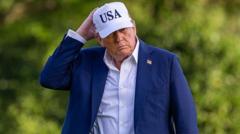The Trump administration's postponement of tariff implementation highlights the complexities of international trade negotiations, as countries respond strategically to U.S. economic policies. Despite initially ambitious goals, the U.S. faces hurdles in achieving desired trade deals while grappling with the impacts of its own tariff strategies.
Global Trade Dynamics Shift as Trump Postpones Tariff Implementation

Global Trade Dynamics Shift as Trump Postpones Tariff Implementation
The United States delays implementing new tariffs, revealing significant challenges in securing trade agreements amidst a shifting global economic landscape.
The United States government has deferred the rollout of new tariffs, a move that reflects ongoing struggles in forming significant trade agreements as well as the evolving dynamics of global commerce. Initially, the Trump administration aimed to finalize "90 deals in 90 days," but as deadlines extend, it appears achieving even nine agreements may be overly optimistic by the August cut-off.
In the latest developments, U.S. Treasury Secretary Scott Bessent confirmed that focus remains on the 18 countries contributing to 95% of America's trade deficit. This strategy essentially recycles prior negotiations without entering new territory, maintaining the same tariff rates disclosed earlier in April.
Despite the U.S.’s intent to wield economic power as leverage, it's evident that most nations are similarly capitalizing on this opportunity to solidify their trade positions. Trade tensions are leading to strained relations, particularly with Japan and South Korea, both of which have expressed dissatisfaction with the U.S. stance. The Japanese finance minister hinted at using their substantial holdings of U.S. government debt as potential leverage in negotiations, which poses unique challenges for U.S. diplomacy.
Financial markets have somewhat acclimated to these rolling delays, with confidence that the U.S. administration may retreat from aggressive tariff policies. However, the underlying issues remain complex, as the global economy continues adapting to shifting trade conditions. For instance, while Chinese exports to the U.S. have dipped by nearly 10%, their overall exports globally are seeing increases, signaling a redirection of trade flows.
Despite record tariff revenues reported in May, the ongoing uncertainty raises questions about the longer-term effects on U.S. economic stability. As the U.S. imposes increasingly high tariffs—now averaging around 15%, compared to historical rates of 2% to 4%—global trade partnerships are realigning, with countries such as the UK and India, and Canada and the EU advancing their own economic agreements.
Though the immediate market reactions remain sedate, experts caution that further disruptions could ignite instability, prompting a need for strategic reassessment from the U.S. as it navigates an increasingly interdependent global economy.
In the latest developments, U.S. Treasury Secretary Scott Bessent confirmed that focus remains on the 18 countries contributing to 95% of America's trade deficit. This strategy essentially recycles prior negotiations without entering new territory, maintaining the same tariff rates disclosed earlier in April.
Despite the U.S.’s intent to wield economic power as leverage, it's evident that most nations are similarly capitalizing on this opportunity to solidify their trade positions. Trade tensions are leading to strained relations, particularly with Japan and South Korea, both of which have expressed dissatisfaction with the U.S. stance. The Japanese finance minister hinted at using their substantial holdings of U.S. government debt as potential leverage in negotiations, which poses unique challenges for U.S. diplomacy.
Financial markets have somewhat acclimated to these rolling delays, with confidence that the U.S. administration may retreat from aggressive tariff policies. However, the underlying issues remain complex, as the global economy continues adapting to shifting trade conditions. For instance, while Chinese exports to the U.S. have dipped by nearly 10%, their overall exports globally are seeing increases, signaling a redirection of trade flows.
Despite record tariff revenues reported in May, the ongoing uncertainty raises questions about the longer-term effects on U.S. economic stability. As the U.S. imposes increasingly high tariffs—now averaging around 15%, compared to historical rates of 2% to 4%—global trade partnerships are realigning, with countries such as the UK and India, and Canada and the EU advancing their own economic agreements.
Though the immediate market reactions remain sedate, experts caution that further disruptions could ignite instability, prompting a need for strategic reassessment from the U.S. as it navigates an increasingly interdependent global economy.




















